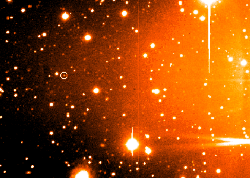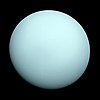Caliban (moon)
 Discovery image of Caliban taken by the Hale Telescope in September 1997 | |
| Discovery[1] | |
|---|---|
| Discovered by |
|
| Discovery site | Hale Telescope at Palomar Obs. |
| Discovery date | 6 September 1997 |
| Designations | |
Designation | Uranus XVI |
| Pronunciation | /ˈkælɪbæn/[2][3] |
Named after | Caliban |
| S/1997 U 2 | |
| Adjectives | Calibanian /kælɪˈbeɪniən/[4] |
| Orbital characteristics[6] | |
| Epoch 27 June 2015 (JD 2457200.5) | |
| Observation arc | 17.96 yr (6,559 d) |
| 7,163,810 km (0.0478871 AU) | |
| Eccentricity | 0.0771431 |
| 1.59 yr (579.26 d) | |
| 294.66253° | |
| 0° 37m 17.345s / day | |
| Inclination | 139.90814° (to the ecliptic) 140.878° (to local Laplace plane)[5] |
| 175.21248° | |
| 342.53671° | |
| Satellite of | Uranus |
| Physical characteristics | |
Mean diameter | 42+20 −12 km[7] |
| Mass | ~2.5×1017 kg (estimate)[8] |
Mean density | ~1.3 g/cm3 (assumed)[8] |
| 9.948±0.019 hr (double-peaked)[7] 2.66±0.04 hr (single-peaked)[9] | |
| Albedo | 0.22+0.20 −0.12[7] |
| Temperature | ~65 K (mean estimate) |
| 22.0 (V)[7] | |
Absolute magnitude (H) | 9.160±0.016[7] 9.0[6] |
Caliban /ˈkælɪbæn/ is the second-largest retrograde irregular satellite of Uranus.[10] It was discovered on 6 September 1997 by Brett J. Gladman, Philip D. Nicholson, Joseph A. Burns, and John J. Kavelaars using the 200-inch Hale telescope together with Sycorax and given the temporary designation S/1997 U 1.[1]
Designated Uranus XVI, it was named after the monster character in William Shakespeare's play The Tempest.
Orbit[]

Uranus · Sycorax · Francisco · Caliban · Stephano · Trinculo
Caliban follows a distant orbit, more than 10 times further from Uranus than the furthest regular moon Oberon.[1] Its orbit is retrograde, moderately inclined and slightly eccentric. The orbital parameters suggest that it may belong to the same dynamic cluster as Stephano and Francisco, suggesting common origin.[11]

The diagram illustrates the orbital parameters of the retrograde irregular satellites of Uranus (in polar co-ordinates) with the eccentricity of the orbits represented by the segments extending from the pericentre to the apocentre.
Physical characteristics[]
Caliban's diameter is estimated to be around 42 km, based on thermal measurements by the Herschel Space Observatory.[7] Its albedo is estimated at around 0.22, which is unusually high compared to those of other Uranian irregular satellites. Neptune's largest irregular satellite, Nereid, has a similarly high albedo as Caliban.[7]
Somewhat inconsistent reports put Caliban in light-red category (B–V = 0.83 V–R = 0.52,[12] B–V = 0.84 ± 0.03 V–R = 0.57 ± 0.03[11]), redder than Himalia but still less red than most Kuiper belt objects. Caliban may be slightly redder than Sycorax.[9] It also absorbs light at 0.7 μm, and one group of astronomers think this may be a result of liquid water that modified the surface.[13]
Measurements of Caliban's light curve by the Kepler space telescope indicate that its rotation period is about 9.9 hours.[7]
Origin[]
Caliban is hypothesized to be a captured object: it did not form in the accretionary disk that existed around Uranus just after its formation. The exact capture mechanism is not known, but capturing a moon requires the dissipation of energy. The possible capture processes include: gas drag in the protoplanetary disk, many body interactions and the capture during the fast growth of the Uranus' mass (so-called "pull-down").[10][11]
See also[]
Footnotes[]
References[]
- ^ a b c Gladman Nicholson et al. 1998.
- ^ "Caliban". Oxford English Dictionary (Online ed.). Oxford University Press. (Subscription or participating institution membership required.)
- ^ Benjamin Smith (1903) The Century Dictionary and Cyclopedia
- ^ Apple, Au, & Gandin (2009) The Routledge international handbook of critical education
- ^ Brozovic, M.; Jacobson, R. A. (2009). "Planetary Satellite Mean Orbital Parameters". The Orbits of the Outer Uranian Satellites, Astronomical Journal, 137, 3834. JPL/NASA. Retrieved 2011-11-06.
- ^ a b "M.P.C. 95215" (PDF). Minor Planet Circular. Minor Planet Center. 29 August 2015.
- ^ a b c d e f g h Farkas-Takács, A.; Kiss, Cs.; Pál, A.; Molnár, L.; Szabó, Gy. M.; Hanyecz, O.; et al. (September 2017). "Properties of the Irregular Satellite System around Uranus Inferred from K2, Herschel, and Spitzer Observations". The Astronomical Journal. 154 (3): 13. arXiv:1706.06837. Bibcode:2017AJ....154..119F. doi:10.3847/1538-3881/aa8365. S2CID 118869078. 119.
- ^ a b "Planetary Satellite Physical Parameters". JPL (Solar System Dynamics). 20 December 2008. Retrieved 10 March 2009.
- ^ a b Maris, Michele; Carraro, Giovanni; Cremonese, Gabrielle; Fulle, Marco (May 2001). "Multicolor Photometry of the Uranus Irregular Satellites Sycorax and Caliban". The Astronomical Journal. 121 (5): 2800–2803. arXiv:astro-ph/0101493. Bibcode:2001AJ....121.2800M. doi:10.1086/320378. S2CID 16273706.
- ^ a b Sheppard, Jewitt & Kleyna 2005.
- ^ a b c Grav, Holman & Fraser 2004.
- ^ Rettig, Walsh & Consolmagno 2001.
- ^ Schmude, Richard (2008). Uranus, Neptune, Pluto and How to Observe Them. Springer. ISBN 978-0-387-76601-0.
- Gladman, B. J.; Nicholson, P. D.; Burns, J. A.; Kavelaars, J. J.; Marsden, B. G.; Williams, G. V.; Offutt, W. B. (1998). "Discovery of two distant irregular moons of Uranus". Nature. 392 (6679): 897–899. Bibcode:1998Natur.392..897G. doi:10.1038/31890. S2CID 4315601.
- Grav, Tommy; Holman, Matthew J.; Fraser, Wesley C. (2004-09-20). "Photometry of Irregular Satellites of Uranus and Neptune". The Astrophysical Journal. 613 (1): L77–L80. arXiv:astro-ph/0405605. Bibcode:2004ApJ...613L..77G. doi:10.1086/424997. S2CID 15706906.
- Rettig, T. W.; Walsh, K.; Consolmagno, G. (December 2001). "Implied Evolutionary Differences of the Jovian Irregular Satellites from a BVR Color Survey". Icarus. 154 (2): 313–320. Bibcode:2001Icar..154..313R. doi:10.1006/icar.2001.6715.
- Sheppard, S. S.; Jewitt, D.; Kleyna, J. (2005). "An Ultradeep Survey for Irregular Satellites of Uranus: Limits to Completeness". The Astronomical Journal. 129 (1): 518–525. arXiv:astro-ph/0410059. Bibcode:2005AJ....129..518S. doi:10.1086/426329. S2CID 18688556.
External links[]
- Moons of Uranus
- Irregular satellites
- Astronomical objects discovered in 1997


